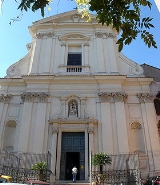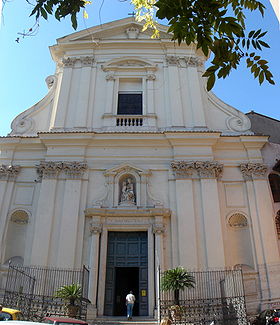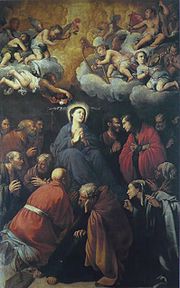
Santa Maria della Scala
Encyclopedia

Mary (mother of Jesus)
Mary , commonly referred to as "Saint Mary", "Mother Mary", the "Virgin Mary", the "Blessed Virgin Mary", or "Mary, Mother of God", was a Jewish woman of Nazareth in Galilee...
of the Staircase) is a titular church in
Churches of Rome
There are more than 900 churches in Rome. Most, but not all, of these are Roman Catholic, with some notable Roman Catholic Marian churches.The first churches of Rome originated in places where Christians met. They were divided into three categories:...
Rome
Rome
Rome is the capital of Italy and the country's largest and most populated city and comune, with over 2.7 million residents in . The city is located in the central-western portion of the Italian Peninsula, on the Tiber River within the Lazio region of Italy.Rome's history spans two and a half...
, found in the Trastevere
Trastevere
Trastevere is rione XIII of Rome, on the west bank of the Tiber, south of Vatican City. Its name comes from the Latin trans Tiberim, meaning literally "beyond the Tiber". The correct pronunciation is "tras-TEH-ve-ray", with the accent on the second syllable. Its logo is a golden head of a lion on a...
neighborhood.
History
The church was built (1593–1610) to honor a miraculous iconIcon
An icon is a religious work of art, most commonly a painting, from Eastern Christianity and in certain Eastern Catholic churches...
of the Madonna. Tradition holds that the icon, when placed on the landing of a staircase of a neighboring house of a mother who prayed before it, had cured her deformed child. Consecrated to Mary, mother of Jesus, it enshrines that icon in the north transept, alongside a baroque statue of St John of the Cross
John of the Cross
John of the Cross , born Juan de Yepes Álvarez, was a major figure of the Counter-Reformation, a Spanish mystic, Catholic saint, Carmelite friar and priest, born at Fontiveros, Old Castile....
. It was sited adjacent to a monastery famous for containing the Papal court's 17th century pharmacy
Pharmacy
Pharmacy is the health profession that links the health sciences with the chemical sciences and it is charged with ensuring the safe and effective use of pharmaceutical drugs...
(its furnishings and equipment has been preserved). In 1650, nearly fifty years after the buildings completion, Carlo Rainaldi
Carlo Rainaldi
Carlo Rainaldi was an Italian architect of the Baroque period.Born in Rome, Rainaldi was one of the leading architects of 17th century Rome, known for a certain grandeur in his designs. He worked at first with his father, Girolamo Rainaldi, a late Mannerist architect in Rome. After his father's...
designed for the church a tempietto-shaped baldachino with 16 slender jasper
Jasper
Jasper, a form of chalcedony, is an opaque, impure variety of silica, usually red, yellow, brown or green in color; and rarely blue. This mineral breaks with a smooth surface, and is used for ornamentation or as a gemstone. It can be highly polished and is used for vases, seals, and at one time for...
Corinthian columns and a high altar.
In 1849, during the last stages of the revolutionary Roman Republic
Roman Republic (19th century)
The Roman Republic was a state declared on February 9, 1849, when the government of Papal States was temporarily substituted by a republican government due to Pope Pius IX's flight to Gaeta. The republic was led by Carlo Armellini, Giuseppe Mazzini and Aurelio Saffi...
's resistance to the invading French forces, Santa Maria della Scala was used as a hospital where Garibaldi
Giuseppe Garibaldi
Giuseppe Garibaldi was an Italian military and political figure. In his twenties, he joined the Carbonari Italian patriot revolutionaries, and fled Italy after a failed insurrection. Garibaldi took part in the War of the Farrapos and the Uruguayan Civil War leading the Italian Legion, and...
's soldiers, wounded in the Trastevere
Trastevere
Trastevere is rione XIII of Rome, on the west bank of the Tiber, south of Vatican City. Its name comes from the Latin trans Tiberim, meaning literally "beyond the Tiber". The correct pronunciation is "tras-TEH-ve-ray", with the accent on the second syllable. Its logo is a golden head of a lion on a...
fighting, were treated.
Art in the Church
Its choir, nave and north transept's vaults transepts are decorated with painting intended to resemble mouldings, whilst the south transept has actual stuccoStucco
Stucco or render is a material made of an aggregate, a binder, and water. Stucco is applied wet and hardens to a very dense solid. It is used as decorative coating for walls and ceilings and as a sculptural and artistic material in architecture...
relief mouldings and an altar and relic (one of her feet) of St Teresa of Avila
Teresa of Ávila
Saint Teresa of Ávila, also called Saint Teresa of Jesus, baptized as Teresa Sánchez de Cepeda y Ahumada, was a prominent Spanish mystic, Roman Catholic saint, Carmelite nun, and writer of the Counter Reformation, and theologian of contemplative life through mental prayer...
.

Carlo Saraceni
Carlo Saraceni was an Italian early-Baroque painter, whose reputation as a "first-class painter of the second rank" was improved with the publication of a modern monograph in 1968....
. The latter replaces Caravaggio's earlier, and more controversial version (see entry here
Death of the Virgin (Caravaggio)
The Death of the Virgin is a painting completed by the Italian Baroque master Caravaggio. It is a near contemporary with the Madonna with Saint Anne now at the Galleria Borghese...
). Rumors held Caravaggio had used a prostitute as a model for the dead virgin. In addition, the disposition of the virgin after her worldly days was and still remains contentious (see Dormition and Assumption of Mary
Assumption of Mary
According to the belief of Christians of the Roman Catholic Church, Eastern Orthodoxy, Oriental Orthodoxy, and parts of the Anglican Communion and Continuing Anglicanism, the Assumption of Mary was the bodily taking up of the Virgin Mary into Heaven at the end of her life...
entries); hence, it was not surprising that the Discalced Carmelites
Discalced Carmelites
The Discalced Carmelites, or Barefoot Carmelites, is a Catholic mendicant order with roots in the eremitic tradition of the Desert Fathers and Mothers...
, who then and now use this church, suspected Caravaggio's version had used lacked decorum, and perhaps edged into heresy.
San Giuseppe Hall houses a collection by Tito Sarrocchi
Tito Sarrocchi
Tito Sarrocchi was an Italian sculptor.-Biography:Sarrocchi was born in Siena and in 1841 moved to Florence where he was taught Fine Arts by Lorenzo Bartolini. He later worked as the chief assistant to Giovanni Duprè. In 1852 he created his first independent work, The Bacchante before returning...
.

